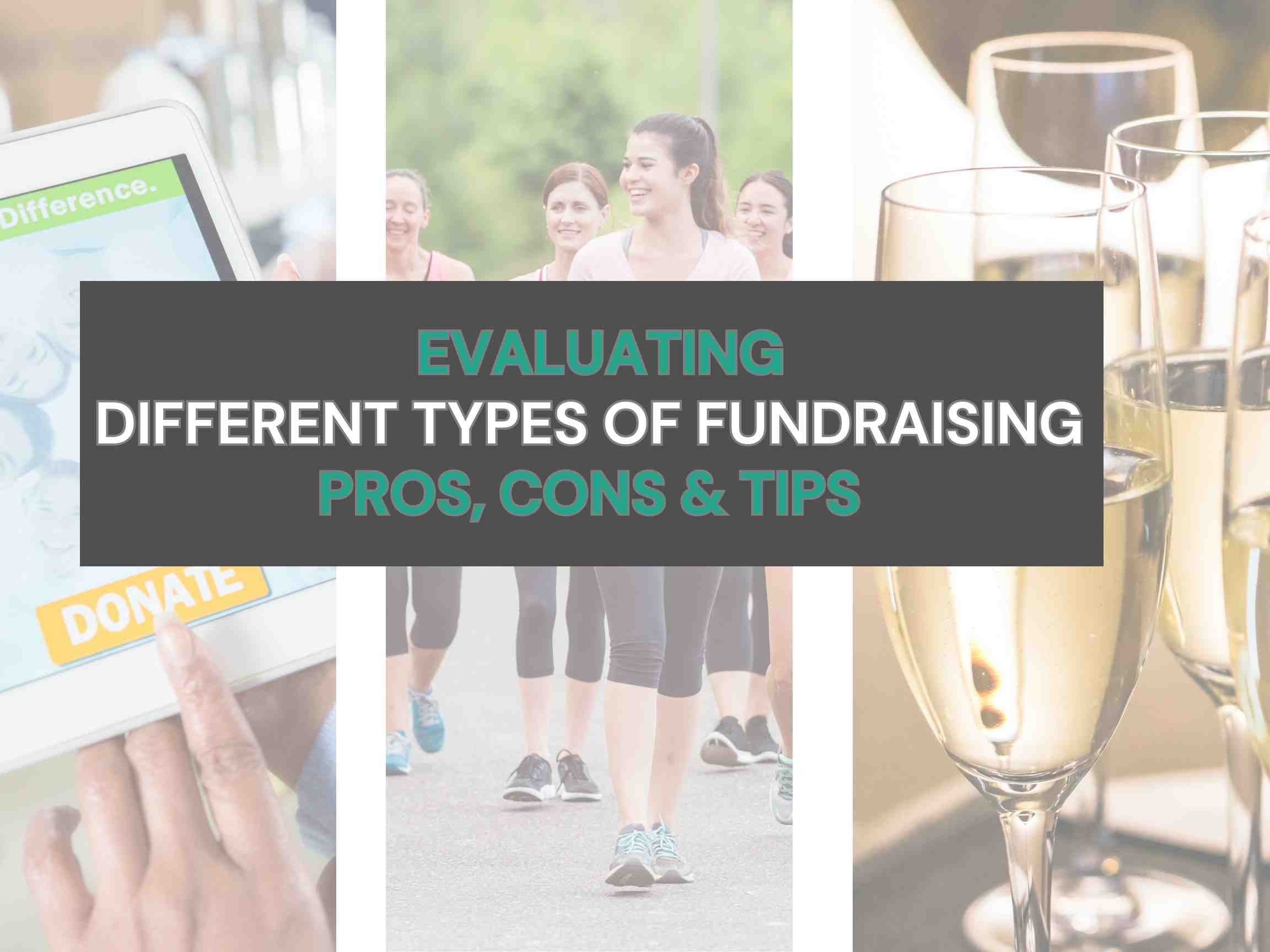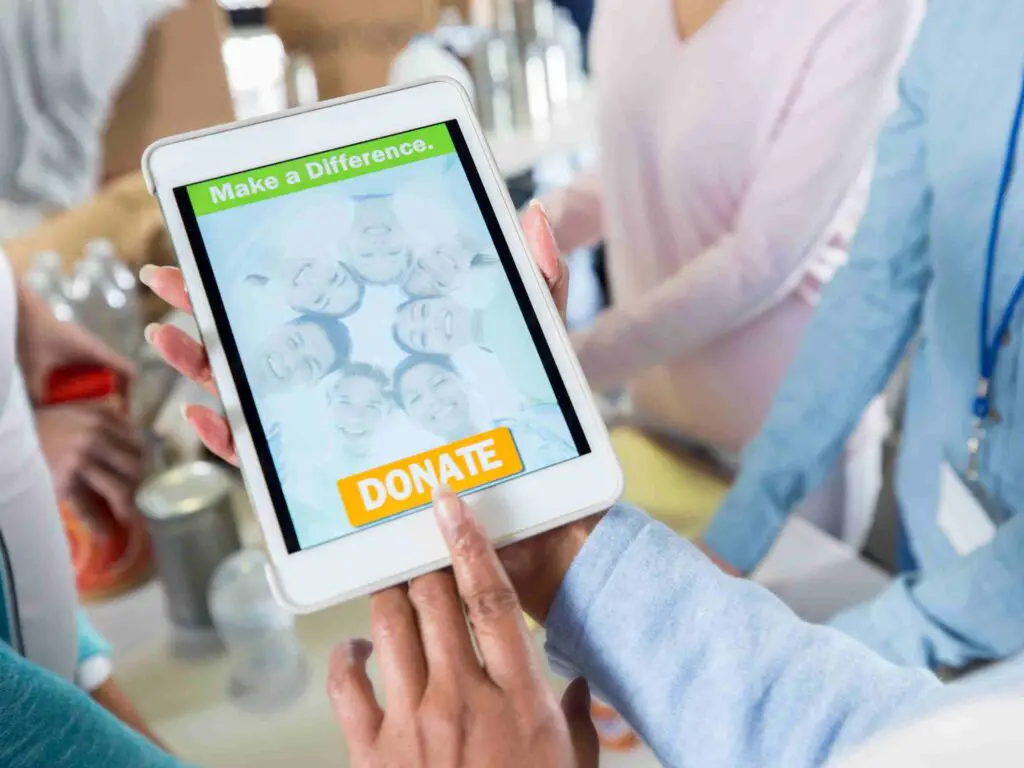Evaluating Different Types of Fundraising: New, Old & Trendy
This post may contain affiliate links. If you purchase through one of these links, I may receive a small commission at no extra cost to you. As an Amazon Associate, I earn from qualifying purchases.

Fundraising is the lifeline of non-profit organizations and understanding the different types of fundraising and choosing the right method for the right cause is critical for fundraising success. However, navigating the myriad of fundraising options can feel overwhelming.
This guide aims to demystify this crucial process. It delves into a diverse range of strategies, from classic methods like crowdfunding to newer trends like cryptocurrency fundraising. You’ll discover the advantages, disadvantages, and ideal use cases for each type, providing you with the insights needed to identify the best fit for your organization.
Beyond this, we also peek into the future, forecasting trends that are set to shape the fundraising landscape. We share expert tips for selecting the right fundraiser, addressing common challenges, and answering frequently asked questions.
The goal? To empower you with knowledge and inspire you to find the fundraising strategy that aligns with your mission, your team, and your supporters.
Types of Common Fundraising
1. Crowdfunding

Crowdfunding is a popular method of fundraising, primarily due to its potential to reach a vast number of people through online platforms. It involves collecting small amounts of money from a large number of individuals, often through websites like Kickstarter or GoFundMe.
- Pros:
- Broad Reach: Internet-based platforms allow campaigns to reach a global audience.
- Cost-Effective: With minimal upfront costs, crowdfunding can be a financially accessible fundraising option.
- Engages Communities: Crowdfunding allows donors to feel directly connected to the cause they’re supporting, building a community around your mission.
- Cons:
- Highly Competitive: With numerous campaigns launched daily, standing out can be challenging.
- Platform Fees: Most crowdfunding sites take a percentage of the funds raised as a fee.
- All-or-Nothing Risk: Some platforms operate on an all-or-nothing model, where if the fundraising goal is not met, all contributions are returned to the donors.
- Best Use Cases: Crowdfunding works best for specific projects or initiatives with a compelling narrative, allowing donors to directly see the impact of their contributions. It’s especially useful for start-ups, creative projects, medical expenses, and community-based initiatives.
2. Peer-to-Peer Fundraising
In peer-to-peer fundraising, supporters raise money on behalf of your organization. They create personalized fundraising pages and share them with their social networks, effectively leveraging their personal relationships for the cause. Peer-to-peer campaigning is often used as a way to support the promotion of a fundraising event or generate more awareness about a cause.
- Pros:
- Extended Reach: By leveraging supporters’ networks, you can connect with potential donors you wouldn’t otherwise reach.
- Personal Engagement: The personal nature of these campaigns can lead to higher engagement and donation rates.
- Supporters Become Advocates: This model not only raises funds but also creates passionate advocates for your cause.
- Cons:
- Dependent on Supporters: The success of the campaign heavily depends on the commitment and motivation of your supporters.
- Difficult to Control: As the campaigns are in the hands of individuals, maintaining consistent messaging can be challenging.
- Potential Donor Fatigue: Supporters reaching out to their networks repeatedly can lead to donor fatigue.
- Best Use Cases: Peer-to-peer fundraising is particularly effective for events, such as walks, runs, or other challenges where participants can rally their network to support their efforts. It can also work well for campaigns where personal stories and experiences can be shared to draw support.
3. Direct Mail Fundraising
Direct mail fundraising involves sending physical letters, postcards, or packages to potential donors. These communications often include a compelling story, a clear call to action, and information about the organization. This is one of the oldest fundraising methods and even after the rise of many other fundraising types becoming popular, continues to serve non-profit organizations.
- Pros:
- Tangible Connection: A physical piece of mail can create a more personal connection compared to digital methods.
- Targeted: Direct mail can be sent to specific demographics or donor groups.
- High Engagement: Despite the digital age, direct mail still enjoys high open and response rates.
- Cons:
- Cost: The costs of printing, materials, and postage can add up.
- Time-Consuming: Creating, printing, and mailing materials can be labor-intensive.
- Hard to Track: It can be challenging to measure the effectiveness of direct mail campaigns.
- Best Use Cases: Direct mail is effective for reaching older demographics who might not be as active online. It also works well for local, community-based organizations or for special occasions, like end-of-year giving campaigns.
4. Event Fundraising

Event fundraising involves hosting an event like a musical fundraising concert, a charity run, a dinner, an auction, or a fundraising fete, etc.—with the aim of raising funds. These events can be held in person or virtually. There is practically no limit to the type and variety of fundraising events that a non-profit could organize. But despite their flexibility, there are many advantages and disadvantages of fundraising from organized events.
- Pros:
- Engaging: Events provide an enjoyable way for supporters to contribute to your cause.
- Relationship Building: They offer an opportunity for direct interaction with donors, fostering deeper connections.
- High Earning Potential: Successful events can raise substantial funds.
- Cons:
- Resource-Intensive: Events can require significant time, effort, and upfront costs to plan and execute.
- Unpredictable: There’s always the risk of low attendance or unforeseen complications affecting the event.
- Temporary: Most events are one-off occurrences, so they do not provide sustained funding.
- Best Use Cases: Event fundraising is ideal for organizations with a strong community presence or for special occasions or milestones. It can also be effective for causes that lend themselves well to a specific event type such as fundraising for foster care, fundraising for choir trips, fundraising for small schools, etc.
5. Corporate Partnerships
Corporate partnerships or sponsorships involve collaborating with businesses to raise funds. This can range from a corporation sponsoring a specific event, matching gifts, or providing grants to a non-profit organization. Corporate sponsorships or partnerships involving large corporates are often executed as part of a company’s corporate social responsibility efforts.
But on a smaller scale, they could even be sought on a local level by tying up with local businesses, restaurants and shops.
- Pros:
- Financially Beneficial: Partnerships can provide significant funding and resources.
- Enhanced Credibility: An association with a well-known corporate entity can enhance a non-profit’s reputation.
- Access to New Networks: Corporate partnerships can expose the non-profit to the company’s audience and resources.
- Cons:
- Complex Negotiations: Forming partnerships can require extensive time and negotiation skills.
- Potential for Misalignment: There’s a risk of partnering with companies whose actions or values might conflict with the non-profit’s mission.
- Dependence: Over-reliance on a single corporate donor can pose risks if that funding is reduced or discontinued.
- Interference: Many corporate sponsors require a say in the decision-making process of a non-profit event which could result in delays and derailment from the original event’s objective.
- Best Use Cases: Corporate partnerships work well for non-profits with causes that align with a corporation’s social responsibility goals. It is also effective for larger non-profits with the capacity to handle complex negotiations and manage these relationships. Corporate sponsorships are non-negotiable for reducing costs when planning large-scale concerts, and huge charity galas. They are the guaranteed way of making fundraising events requiring many volunteers and upfront costs feasible.
6. Planned Giving
Planned giving, or legacy giving, involves donors making a commitment to contribute a major gift, often towards the end of their life, as part of their financial or estate planning. This could include bequests in wills, annuities, trusts, or life insurance policies.
- Pros:
- Large Donations: Planned gifts are often larger than other types of donations.
- Financially Beneficial for Donors: Many planned giving options provide tax benefits for the donors.
- Future Funding Security: Planned gifts can provide a future source of income for the non-profit.
- Cons:
- Long-Term: The benefits of planned giving often aren’t seen until many years in the future.
- Legal Complexity: Planned giving can involve complex legal and financial planning.
- Requires a Developed Program: It requires dedicated staff and resources to manage and promote a planned giving program.
- Best Use Cases: Planned giving is effective for non-profits with a long-standing history and a trust-based relationship with their donors. It is also beneficial for organizations with a demographic of older supporters who are considering estate or financial planning.
7. Major Gifts
Major gifts are significant financial donations made by individuals to non-profit organizations. The threshold for what constitutes a “major gift” varies depending on the organization’s size and budget or the size and scale of a particular campaign. There is no standard definition or size of what amounts to a major gift.
- Pros:
- Significant Impact: A single major gift can have a substantial impact on an organization’s funding.
- Building Relationships: Cultivating major donors often leads to strong, long-lasting relationships.
- Greater Stability: Major gifts can provide a more predictable revenue stream.
- Cons:
- Requires Significant Effort: Identifying, cultivating, and stewarding major donors can be time-consuming.
- Competition: There’s significant competition for major donors in the non-profit sector.
- Donor Influence: Large donors may seek to influence the organization’s activities or direction.
- Best Use Cases: Major gifts are particularly effective for established organizations with the capacity to invest in donor cultivation and stewardship. They also work well for non-profits able to demonstrate a significant impact that appeals to these donors. Major gifts are best used for organization-level contributions rather than for funding specific events.
8. Grants

Grants are funds given by grant-making entities like government departments, corporations, or foundations. They can be general operating grants or project-specific. The way to secure a grant is to make a detailed application to the relevant grant-making body as per their guidelines and requirements.
- Pros:
- Non-Repayable: Unlike loans, grants do not need to be repaid.
- Significant Funding: Grants can provide substantial amounts of money.
- Credibility: Receiving a grant can enhance the reputation and credibility of your non-profit.
- Cons:
- Time-Consuming: The grant application process can be lengthy and labor-intensive.
- Highly Competitive: There’s often significant competition for grants.
- Restricted Use: Some grants come with strict stipulations on how the funds can be used.
- Best Use Cases: Grants are particularly suitable for non-profits that align with the priorities of grant-making entities, such as schools and colleges, health, or social services. In fact, grant writing is one of the best ways to fundraise for charter schools that are engaged in the cause of imparting education but receive lesser per-student funding than other public schools. They can also be beneficial for specific projects or programs that need funding.
9. In-Kind Donations

In-kind donations involve goods or services being given instead of cash. These can include items like office supplies, technical equipment, professional services, or donated space. Inviting in-kind donations is a common way of raising funds without actually raising money. Donors also find making in-kind donations a lot less taxing than the need to regularly make monetary contributions.
- Pros:
- Cost-Saving: In-kind donations can save non-profits significant expenses in their operating budget.
- Practical: These donations often meet immediate, practical needs.
- Community Engagement: They provide a way for individuals or businesses who may not be able to contribute financially to support your work.
- Cons:
- Not Always Useful: Some in-kind donations may not meet the non-profit’s current needs.
- Storage: Physical goods may require storage space.
- Valuation: It can be difficult to assign a financial value to these donations for reporting purposes.
- Best Use Cases: In-kind donations can be particularly useful for start-ups or smaller non-profits with limited funds. They also work well for non-profits running specific projects that need materials or services, such as a building project or collecting school supplies for children.
Modern Types of Common Fundraising
1. Digital Fundraising

Digital fundraising involves the use of digital technology to attract donations. Of all the different types of fundraising, digital fundraising covers the widest array of techniques like email campaigns, digital advertising, online auctions, virtual fundraising events, and more. While email campaigns and digital advertising have been used for a few years now, virtual events and online auctions gained traction in the recent past when conducting physical meet-ups and events had become impossible.
- Pros:
- Wide Reach: Digital platforms can reach a large, global audience quickly.
- Cost-Effective: Compared to traditional fundraising methods, digital fundraising can be less expensive.
- Real-Time Tracking: The success of digital campaigns can be easily tracked and measured.
- Cons:
- Changing Algorithms: The success of digital campaigns can be affected by changes in the search engine or social media algorithms.
- Privacy Concerns: Handling digital data requires strict adherence to privacy laws and standards.
- Short Attention Spans: With so much information available online, it can be challenging to capture and maintain people’s attention.
- Best Use Cases: Digital fundraising is particularly effective for campaigns with a strong emotional or visual component that can be shared digitally. It is also beneficial for non-profits targeting a younger, more tech-savvy demographic. It is also an excellent way to fundraise when you do not have enough volunteers, are a relatively new organization, or running a campaign that is faced with the challenge of limited availability of possible donors or funding budgets.
2. Social Media Fundraising
Social media fundraising utilizes platforms like Facebook, Instagram, Twitter, and LinkedIn to connect with and raise funds from supporters. This could include “Donate Now” buttons, fundraising campaigns, and events promoted on social media platforms.
- Pros:
- Broad Reach: Social media provides access to a large and diverse audience.
- Engaging: The interactive nature of social media can foster higher engagement levels.
- Viral Potential: Compelling campaigns have the potential to go viral, reaching a much larger audience.
- Cons:
- Requires Consistent Effort: Maintaining an active and engaging social media presence requires consistent effort and creativity.
- Platform Limitations: Each platform has its own rules and limitations regarding fundraising.
- Low Conversion Rates: While social media has a wide reach, conversion rates for donations can be low.
- Best Use Cases: Social media fundraising is effective for awareness campaigns, smaller projects, or time-bound campaigns. It can also be beneficial for non-profits with a strong community of online supporters who can share and promote the cause.
3. Mobile Giving
Mobile giving involves donating through mobile devices, often through a dedicated app or via text message. Donors can contribute anytime, anywhere, using their smartphones. There are plenty of apps and platforms that offer mobile giving services such as Donorbox, Charity Miles, Coin Up, etc.
- Pros:
- Convenience: Mobile giving is easy and convenient for donors, requiring just a few taps on a device they use regularly.
- Instantaneous: Donations can be made and processed immediately.
- Increased Engagement: Regular interaction through mobile notifications can foster donor engagement.
- Cons:
- Technological Barriers: Some donors may be uncomfortable or unfamiliar with mobile technology.
- Payment Security: Ensuring secure transactions and maintaining donor trust is crucial.
- Limited Information: Due to screen size, providing detailed information about the cause or campaign can be challenging.
- Best Use Cases: Mobile giving is particularly suitable for disaster relief or other urgent causes, where immediate donations are crucial. It is also effective for non-profits targeting a younger, tech-savvy demographic. It is useful for campaigns where donors can take quick decisions and not for campaigns that require substantial persuasion of donors.
4. Virtual Reality/Augmented Reality Fundraising
Virtual Reality (VR) and Augmented Reality (AR) fundraising use immersive technology to engage donors. This could include virtual tours, simulations of the impact of a donation, or augmented reality experiences that overlay digital information onto the physical world.
- Pros:
- Immersive Experience: VR/AR can provide a uniquely immersive and engaging donor experience.
- Storytelling: These technologies can be powerful storytelling tools, bringing a non-profit’s work to life.
- Innovative Appeal: VR/AR can attract attention and interest due to its novelty and cutting-edge feel.
- Cons:
- Technical Complexity: Creating VR/AR experiences can be technically complex and require expert knowledge.
- Cost: Developing VR/AR experiences can be expensive.
- Limited Accessibility: Not all donors have access to VR/AR technology.
- Best Use Cases: VR/AR fundraising can be particularly effective for non-profits with visually impactful work, like wildlife conservation or construction projects. It’s also suitable for organizations looking to target a tech-savvy, younger demographic.
Upcoming Trends and Types of Fundraising
Cryptocurrency Donations
Cryptocurrency Donations are starting to take center stage in the digital era. As cryptocurrencies like Bitcoin and Ethereum gain mainstream acceptance, more non-profits are beginning to tap into this new funding source. By accepting these digital currencies, organizations can access a fresh donor base that appreciates the ease and innovation of blockchain technology. This trend is particularly pertinent for groups that cater to younger, tech-savvy audiences, or for organizations that work across borders and want to streamline their donation processes.
Non-Fungible Tokens based fundraising
Non-fungible tokens (NFTs) have exploded in popularity recently. NFTs can represent ownership or proof of authenticity of a unique item or piece of content on the blockchain. Nonprofits can consider minting their own NFTs as a unique fundraising method. They could create digital artwork or other digital assets, sell them as NFTs, and then use the proceeds to fund their work.
Subscription Giving
Inspired by the popularity of subscription services in the consumer sector (like Netflix or Amazon Prime), some nonprofits are starting to offer subscription giving options. Donors sign up to give a set amount each month, providing nonprofits with a steady stream of predictable revenue.
Dos and Don’ts – Tips for Choosing the Right Type of Fundraising Method
Do’s:
- Do Understand Your Donor Base: Different donors respond to different types of fundraising. For instance, younger donors might be more inclined to participate in digital fundraising efforts like crowdfunding, while older demographics might prefer traditional direct mail appeals or events. Understanding your donor base demographics can help you tailor your fundraising strategies for maximum impact.
- Do Align with Your Organization’s Mission and Values: Your fundraising activities should reflect your organization’s mission and values. For example, if your nonprofit focuses on environmental conservation, consider organizing a tree-planting drive or using sustainable materials in your fundraising events. This alignment not only builds credibility but also reinforces your organization’s purpose among your supporters.
- Do Consider Your Resources: Assess your available resources — human, financial, and time — before deciding on a fundraising activity. Planning a large-scale fundraising event may seem appealing, but it can be costly and require significant manpower. Smaller nonprofits or those with limited resources might find more success with low-cost, high-impact strategies like peer-to-peer fundraising or email campaigns.
- Do Evaluate Past Performance: Historical data is a powerful tool. Look back at your past fundraising initiatives — which were most successful? Which didn’t yield the expected results? Understanding what has worked (or not worked) for your organization in the past can provide valuable insights into what might work best moving forward.
- Do Set Clear Goals: Having a clear vision of what you want to achieve makes it easier to choose the right fundraising strategy. Are you aiming to raise a specific amount of money, attract new donors, or perhaps raise awareness for a particular project or cause? Different goals can be better served by different types of fundraisers.
- Do Experiment and Learn: The fundraising landscape is ever-changing, with new strategies and technologies emerging regularly. Be open to trying out new fundraising techniques. Even if every new initiative isn’t a hit, there’s always something to be learned from the process.
- Do Stay Current with Trends: Emerging fundraising trends can provide new opportunities for nonprofits. Regularly review current trends and innovations in the fundraising field and consider whether and how they might be integrated into your own fundraising strategy.
Don’ts:
- Don’t Ignore Your Supporters’ Preferences: Just because a fundraising strategy is trendy doesn’t mean it’s right for your organization. Always consider your supporters’ preferences and giving habits.
- Don’t Stray from Your Mission: Avoid fundraising activities that may contradict or cloud your organization’s mission and values. Consistency and authenticity are key to maintaining trust with your supporters.
- Don’t Overstretch Your Resources: While it’s good to be ambitious, it’s also important to be realistic. Overcommitting resources to a fundraising campaign can lead to burnout and can detract from other important work.
- Don’t Repeat Past Mistakes: If certain fundraising strategies haven’t worked for your organization in the past, it’s important to understand why before trying them again.
- Don’t Neglect to Set Goals: Every fundraising initiative should have defined goals. Without clear objectives, it’s difficult to measure success or determine the return on investment.
- Don’t Fear Innovation: While it’s important to rely on tried-and-true fundraising strategies, don’t be afraid to try something new. Sometimes the most innovative ideas can yield the greatest results.
- Don’t Neglect Current Trends: While not every fundraising trend will be applicable to your organization, staying informed about the current fundraising landscape can help you spot new opportunities and keep your strategies fresh.
Final Thoughts
Selecting the right fundraising strategy is a pivotal task that can shape the future of your nonprofit. It’s a blend of understanding your donors, aligning with your mission, and staying abreast of trends. There’s no one-size-fits-all, so the key is to keep learning, experimenting, and adapting. Whether you’re leveraging traditional methods or exploring cutting-edge trends, the perfect blend can propel your mission, making a significant impact.






